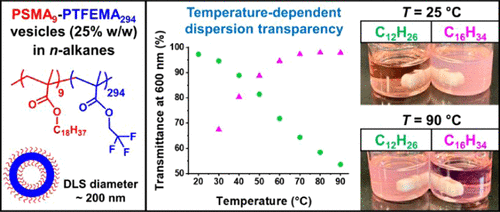当前位置:
X-MOL 学术
›
Macromolecules
›
论文详情
Our official English website, www.x-mol.net, welcomes your
feedback! (Note: you will need to create a separate account there.)
Synthesis of Highly Transparent Diblock Copolymer Vesicles via RAFT Dispersion Polymerization of 2,2,2-Trifluoroethyl Methacrylate in n-Alkanes
Macromolecules ( IF 5.1 ) Pub Date : 2021-01-22 , DOI: 10.1021/acs.macromol.0c02646 Csilla György 1 , Matthew J Derry 1 , Erik J Cornel 1 , Steven P Armes 1
Macromolecules ( IF 5.1 ) Pub Date : 2021-01-22 , DOI: 10.1021/acs.macromol.0c02646 Csilla György 1 , Matthew J Derry 1 , Erik J Cornel 1 , Steven P Armes 1
Affiliation

|
RAFT dispersion polymerization of 2,2,2-trifluoroethyl methacrylate (TFEMA) is performed in n-dodecane at 90 °C using a relatively short poly(stearyl methacrylate) (PSMA) precursor and 2-cyano-2-propyl dithiobenzoate (CPDB). The growing insoluble poly(2,2,2-trifluoroethyl methacrylate) (PTFEMA) block results in the formation of PSMA–PTFEMA diblock copolymer nano-objects via polymerization-induced self-assembly (PISA). GPC analysis indicated narrow molecular weight distributions (Mw/Mn ≤ 1.34) for all copolymers, with 19F NMR studies indicating high TFEMA conversions (≥95%) for all syntheses. A pseudo-phase diagram was constructed to enable reproducible targeting of pure spheres, worms, or vesicles by varying the target degree of polymerization of the PTFEMA block at 15–25% w/w solids. Nano-objects were characterized using dynamic light scattering, transmission electron microscopy, and small-angle X-ray scattering. Importantly, the near-identical refractive indices for PTFEMA (1.418) and n-dodecane (1.421) enable the first example of highly transparent vesicles to be prepared. The turbidity of such dispersions was examined between 20 and 90 °C. The highest transmittance (97% at 600 nm) was observed for PSMA9–PTFEMA294 vesicles (237 ± 24 nm diameter; prepared at 25% w/w solids) in n-dodecane at 20 °C. Interestingly, targeting the same diblock composition in n-hexadecane produced a vesicle dispersion with minimal turbidity at a synthesis temperature of 90 °C. This solvent enabled in situ visible absorption spectra to be recorded during the synthesis of PSMA16–PTFEMA86 spheres at 15% w/w solids, which allowed the relatively weak n→π* band at 515 nm assigned to the dithiobenzoate chain-ends to be monitored. Unfortunately, the premature loss of this RAFT chain-end occurred during the RAFT dispersion polymerization of TFEMA at 90 °C, so meaningful kinetic data could not be obtained. Furthermore, the dithiobenzoate chain-ends exhibited a λmax shift of 8 nm relative to that of the dithiobenzoate-capped PSMA9 precursor. This solvatochromatic effect suggests that the problem of thermally labile dithiobenzoate chain-ends cannot be addressed by performing the TFEMA polymerization at lower temperatures.
中文翻译:

甲基丙烯酸 2,2,2-三氟乙酯在正烷烃中的 RAFT 分散聚合合成高透明二嵌段共聚物囊泡
使用相对较短的聚甲基丙烯酸硬脂酯 (PSMA) 前体和二硫代苯甲酸 2-氰基-2-丙酯 (CPDB) 在正十二烷中于 90 °C 下进行甲基丙烯酸 2,2,2-三氟乙酯 (TFEMA) 的 RAFT 分散聚合。不断增长的不溶性聚(2,2,2-甲基丙烯酸三氟乙酯)(PTFEMA)嵌段导致通过聚合诱导自组装(PISA)形成PSMA-PTFEMA二嵌段共聚物纳米物体。 GPC 分析表明所有共聚物的分子量分布较窄( M w / Mn ≤ 1.34), 19 F NMR 研究表明所有合成的 TFEMA 转化率较高(≥95%)。构建了伪相图,通过将 PTFEMA 块的目标聚合度改变为 15-25% w/w 固体,能够以可重复的方式靶向纯球体、蠕虫或囊泡。使用动态光散射、透射电子显微镜和小角 X 射线散射对纳米物体进行表征。重要的是,PTFEMA (1.418) 和正十二烷 (1.421) 的折射率几乎相同,使得能够制备出第一个高度透明的囊泡实例。在 20 至 90 °C 之间检查此类分散体的浊度。在 20 °C 的正十二烷中,观察到 PSMA 9 –PTFEMA 294囊泡(直径 237 ± 24 nm;以 25% w/w 固体制备)的最高透射率(600 nm 处为 97%)。有趣的是,针对正十六烷中的相同二嵌段组合物,在 90 °C 的合成温度下产生了具有最小浊度的囊泡分散体。 该溶剂能够在 15% w/w 固体的 PSMA 16 –PTFEMA 86球体合成过程中记录原位可见吸收光谱,从而允许分配给二硫代苯甲酸酯链端的 515 nm 处相对较弱的 n→π* 谱带被监控。不幸的是,在 90 °C TFEMA 的 RAFT 分散聚合过程中,该 RAFT 链端过早丢失,因此无法获得有意义的动力学数据。此外,相对于二硫代苯甲酸酯封端的 PSMA 9前体,二硫代苯甲酸酯链端的 λ最大位移为 8 nm。这种溶剂化显色效应表明,热不稳定的二硫代苯甲酸酯链端的问题不能通过在较低温度下进行 TFEMA 聚合来解决。
更新日期:2021-02-09
中文翻译:

甲基丙烯酸 2,2,2-三氟乙酯在正烷烃中的 RAFT 分散聚合合成高透明二嵌段共聚物囊泡
使用相对较短的聚甲基丙烯酸硬脂酯 (PSMA) 前体和二硫代苯甲酸 2-氰基-2-丙酯 (CPDB) 在正十二烷中于 90 °C 下进行甲基丙烯酸 2,2,2-三氟乙酯 (TFEMA) 的 RAFT 分散聚合。不断增长的不溶性聚(2,2,2-甲基丙烯酸三氟乙酯)(PTFEMA)嵌段导致通过聚合诱导自组装(PISA)形成PSMA-PTFEMA二嵌段共聚物纳米物体。 GPC 分析表明所有共聚物的分子量分布较窄( M w / Mn ≤ 1.34), 19 F NMR 研究表明所有合成的 TFEMA 转化率较高(≥95%)。构建了伪相图,通过将 PTFEMA 块的目标聚合度改变为 15-25% w/w 固体,能够以可重复的方式靶向纯球体、蠕虫或囊泡。使用动态光散射、透射电子显微镜和小角 X 射线散射对纳米物体进行表征。重要的是,PTFEMA (1.418) 和正十二烷 (1.421) 的折射率几乎相同,使得能够制备出第一个高度透明的囊泡实例。在 20 至 90 °C 之间检查此类分散体的浊度。在 20 °C 的正十二烷中,观察到 PSMA 9 –PTFEMA 294囊泡(直径 237 ± 24 nm;以 25% w/w 固体制备)的最高透射率(600 nm 处为 97%)。有趣的是,针对正十六烷中的相同二嵌段组合物,在 90 °C 的合成温度下产生了具有最小浊度的囊泡分散体。 该溶剂能够在 15% w/w 固体的 PSMA 16 –PTFEMA 86球体合成过程中记录原位可见吸收光谱,从而允许分配给二硫代苯甲酸酯链端的 515 nm 处相对较弱的 n→π* 谱带被监控。不幸的是,在 90 °C TFEMA 的 RAFT 分散聚合过程中,该 RAFT 链端过早丢失,因此无法获得有意义的动力学数据。此外,相对于二硫代苯甲酸酯封端的 PSMA 9前体,二硫代苯甲酸酯链端的 λ最大位移为 8 nm。这种溶剂化显色效应表明,热不稳定的二硫代苯甲酸酯链端的问题不能通过在较低温度下进行 TFEMA 聚合来解决。






























 京公网安备 11010802027423号
京公网安备 11010802027423号